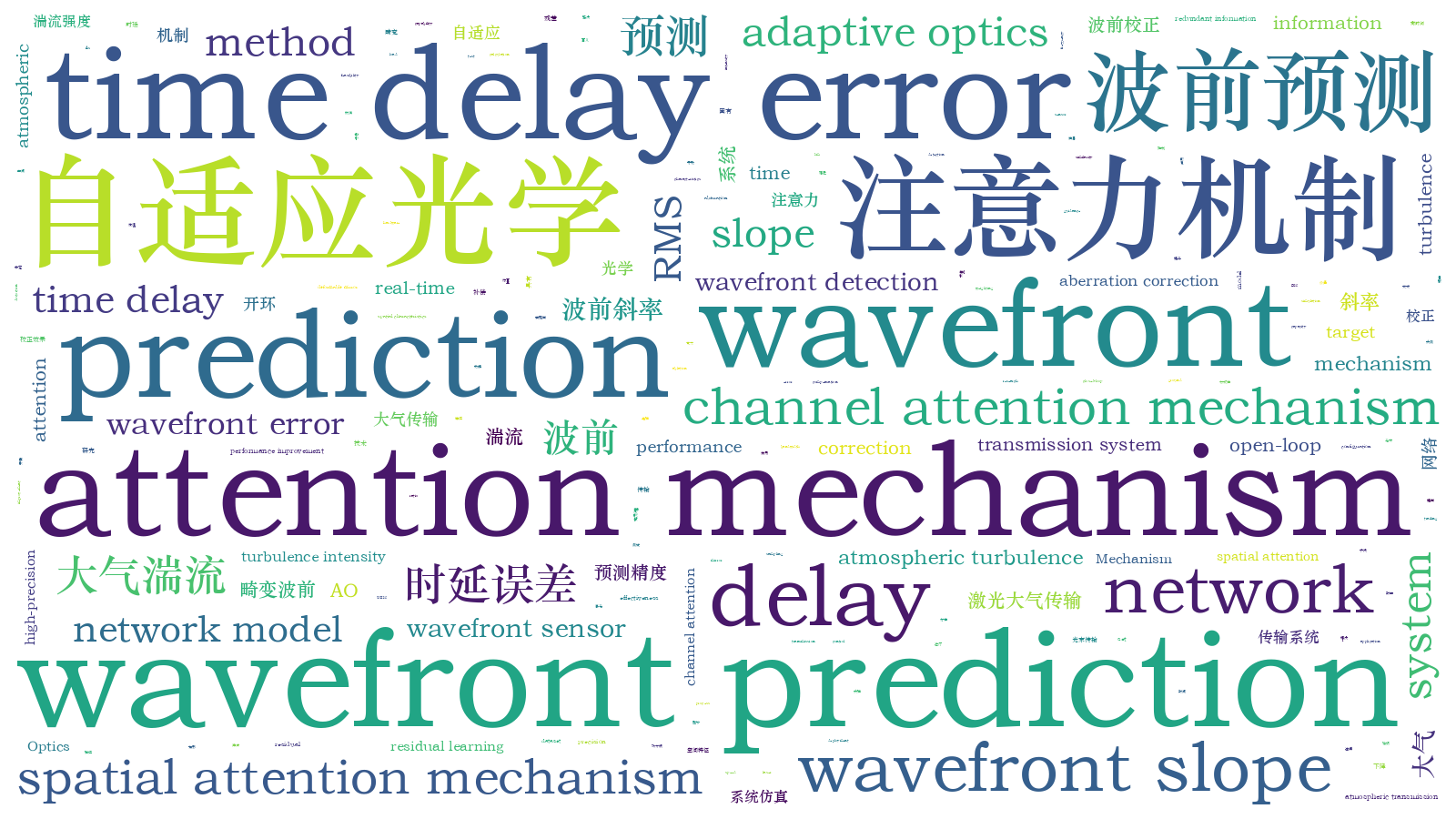基于注意力机制的自适应光学开环斜率预测【增强内容出版】
Adaptive optics (AO) are commonly utilized for real-time wavefront detection and aberration correction. Nevertheless, a typical AO system often experiences a time delay equivalent to at least 2?3 sampling periods due to wavefront sensor readout data delay and control calculation delay. Hence, existing AO systems do not offer truly real-time corrections. When the frequency of turbulence alterations surpasses the closed-loop bandwidth of the AO system, this delay leads to the compensation wavefront on the deformable mirror (DM) trailing the changes in the distortion wavefront. This lag substantially hampers the correction efficacy of the AO technology. Consequently, predicting future atmospheric turbulence information in real-time bears significant research importance and practical value in AO technology.
In this paper, a spatiotemporal prediction network was proposed for AO wavefronts based on the attention mechanism. This network simultaneously considered the temporal and spatial characteristics of atmospheric turbulence and selected the slope data, which was easier to acquire in the AO system and had a lower dimension, as both the input and output of the network. With only six frames of previous wavefront slope information, the wavefront slope of the second frame at a subsequent moment was determined. The network initially employed the spatial attention mechanism to capture similar target features in each frame of the distorted wavefront. It then utilized the residual learning strategy to remove redundant information between the input wavefronts of two consecutive frames, producing refined target features. Additionally, recognizing that the degree of target feature information in each frame of the distorted wavefront varied, the channel attention mechanism was further employed. This mechanism emphasized distorted wavefronts containing a richer set of target feature values rather than evenly weighting the wavefront from each frame. Following these steps, the final prediction of the wavefront slope was realized.
The generalizability of the distorted wavefront dataset is tested under different atmospheric turbulence intensities. As the turbulence intensity increases, the structural similarity (SSIM) between the predicted and true wavefronts stabilizes above 0.9300, and the ratio of the root-mean-square wavefront error (RMSe) between the predicted and true wavefronts to the true RMS is stable at approximately 5.00% (Table 2). In the two-frame delay system, when compared to the non-prediction method, the performance improvement of the proposed prediction method is stable at approximately 40% (Fig. 4). Extended tests are performed on the three-frame-delay AO system under the assumption that the RMSe increases when compared with the two-frame delay prediction; however, the performance of the proposed prediction method increases by more than 43% when compared with that of the non-predicted method (Fig. 5). Additionally, a set of ablation comparison experiments are conducted. Under the assumption of a two-frame delay system, compared to the non-prediction method, the RMSe based on the attention mechanism and residual learning prediction methods reduce by approximately 29% and 16%, respectively, while that based on the proposed method reduces by approximately 40% (Fig. 7). To further verify the performance of the proposed prediction network, we test the one-time open-loop data collected by an actual 1 km laser atmospheric transmission system (Table 3); the average ground truth RMS of the experimental data is 0.9488λ, the average prediction RMS is approximately 0.9557λ, the average RMSe is approximately 0.0675λ, and the RMSe is approximately 7.1% of the real true RMS (Fig. 9). Furthermore, to demonstrate the prediction capability of the network for the experimental data, we extend the simulation of the three-frame delay open-loop correction process again. Compared to the non-predicted method, in two-frame delay and three-frame delay systems, the average performance improvements of the proposed prediction method are 41.2% and 42.9%, respectively (Fig. 10). This reiterates the effectiveness of the proposed open-loop slope prediction network and the feasibility of applying this network model to open-loop correction systems.
In this study, an AO open-loop slope-prediction-network-based attention mechanism is proposed to achieve high-precision wavefront slope prediction. The effectiveness of the network is experimentally proven, which can effectively overcome the inherent delay problem of real AO systems. Additionally, the network uses only six consecutive frames of wavefront slope prior information to achieve a high-precision actual wavefront for correction. This input and output configuration reduces the hardware system's load capacity and enhances the network model's running speed, offering crucial guidance and application value for the subsequent deployment of an actual AO delay system.
王宁, 朱里程, 葛欣兰, 高泽宇, 王帅, 杨平. 基于注意力机制的自适应光学开环斜率预测[J]. 中国激光, 2024, 51(6): 0605001. Ning Wang, Licheng Zhu, Xinlan Ge, Zeyu Gao, Shuai Wang, Ping Yang. Open-Loop Slope Prediction in Adaptive Optics Based on Attention Mechanism[J]. Chinese Journal of Lasers, 2024, 51(6): 0605001.







